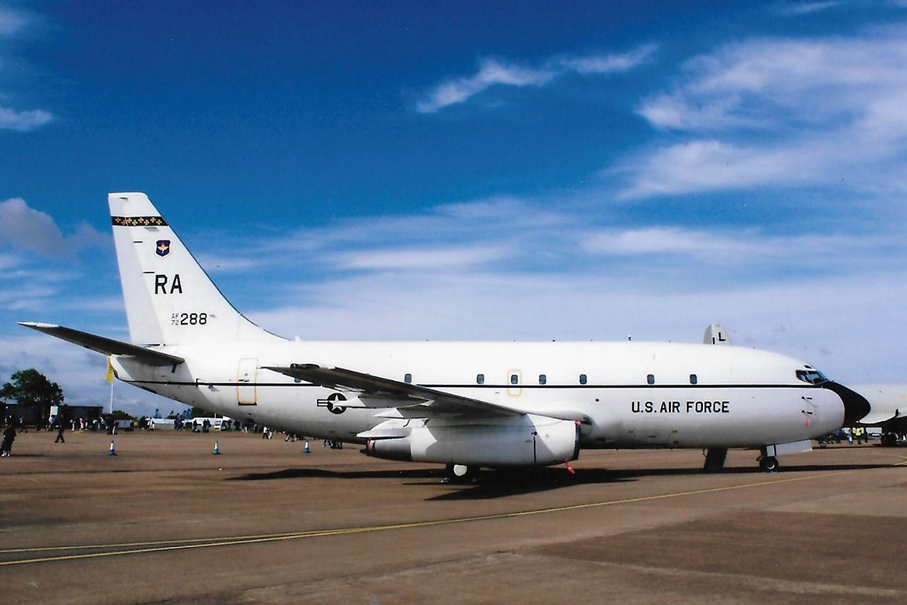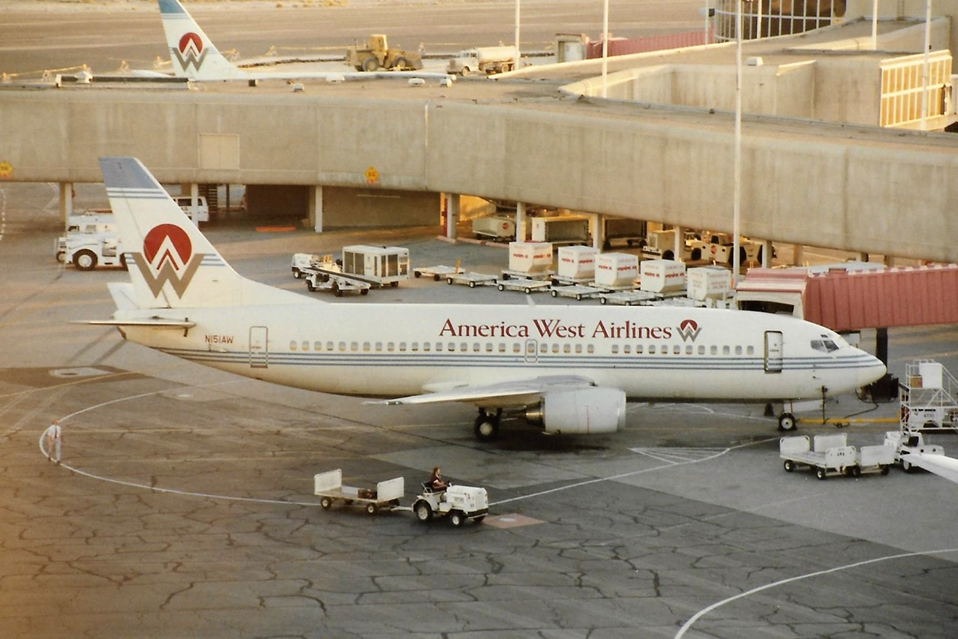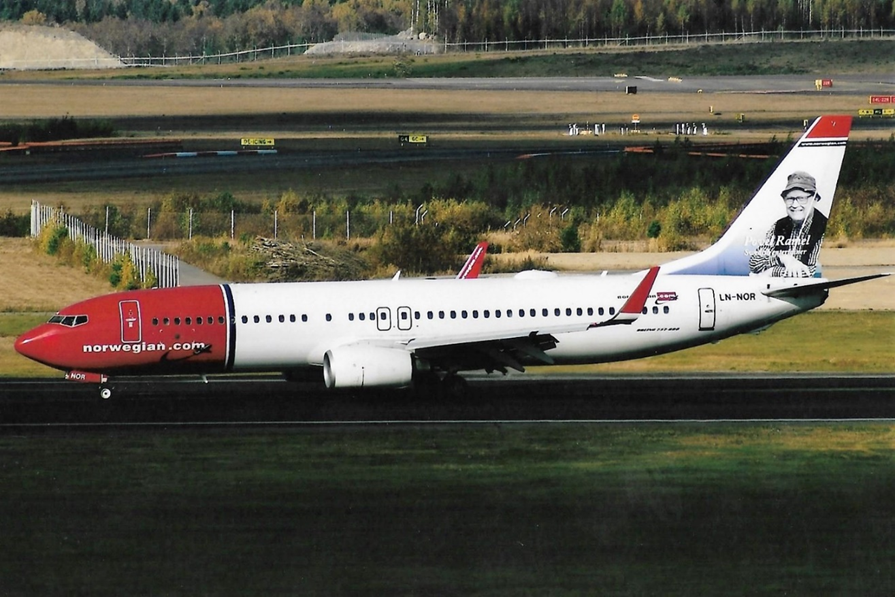


From its entry into airline service with Lufthansa in February 1968 to the present day, you could visit any airport around the world and very likely see an example of Boeing’s best selling jet. With nearly 11,000 built, 400 waiting to be delivered and orders for many more this aeroplane is an icon of the airliner world. This baby Boeing is of course the Boeing 737 series.

Back in the mid-1960s Boeing was busy building 707s for long haul flights and 727s for internal medium range flights. This was fine and dandy if you didn’t live in a small US town away from a major hub airport. Seeing a gap in the market Boeing turned its attention to producing a short haul airliner to ferry these people to bigger airports where they could connect (hopefully using another Boeing) to their final destination. Using the original Boeing 707 fuselage profile and 60 per cent of the design and systems from the 727 enabled the designers to quickly offer a twin-engine aeroplane with six abreast seating. However the 707 solution of hanging the engines off pylons on the wing wouldn’t work as the short fuselage of the 737 meant the engines would get in the away of the airstairs. The answer was simple, just bolt the engines directly to the bottom of the wing and the well-known shape of the early 737 was born. Designed to carry 85 passengers in a two-class layout the Boeing 737-100 prototype first flew in April 1967. At first there was very little interest from US airlines as they were still happy to fly their short-haul routes with piston powered aircraft such as Convair 440s and Martin 4-0-4s. It took foreign airline Lufthansa to place the first order. Jets had taken off on the short haul routes much quicker in Europe than the USA with BEA using Tridents and most other major European airlines opting for the Sud Aviation Caravelle or the Douglas DC-9. Lufthansa needed to get in the jet club and the new offering from Boeing suited its demands perfectly.

With the introduction into service with Lufthansa US airlines began to take note of the new jet. It was generally felt that 85 seats would not be enough so Boeing offered a stretched version capable of carrying 102 passengers and United Airlines put the new version now called the 737-200 into service in April 1968. Several other airlines also ordered this larger version such that it became the standard aircraft offered by Boeing and -100 production ceased after just 30 airframes. Today the very first -100 built has been donated by NASA, it’s last operator back, to Boeing for their Museum of Flight, this is the only surviving -100 . The -200 was used not just as a passenger airliner but as a cargo aircraft as well with a large forward fuselage door. The USAF also used it as a navigation trainer called the T-43. Such was the demand for this larger version of the 737, 1114 would be built. In 1971 the 737-200 underwent an upgrade programme which gave it an increased payload and range plus several system improvements such as autobrake for shortened landing runs. These upgraded aeroplanes were known as the 737-200 Advanced. Lufthansa and British Airways both ordered this variant but with the addition of the first digital autopilot fitted to a production 737. But these BA aircraft would not be the first to arrive in the UK that honour had fallen to Britannia Airways back in 1968.

The 737-200 became one of the most popular variants of the 737 and saw operation with airlines all around the world. When they were replaced with newer aircraft many had the freight door of the cargo version fitted and continued flying as freighters. There was even a version called the 737-200QC which gave the best of both worlds as the ‘Quick Change’ version, which allowed the seats to be fitted on pallets which could be quickly removed through the freight door to convert the aircraft into a freighter. This was useful for airlines which flew passengers during the day and freight during the night. The last 737-200 was delivered in 1988 and the last passenger-configured scheduled flight in the US took place in 2008 with Aloha Airlines.

The long production of the 737 can be broken down into four type groups, the 100/200 are known as the ‘originals’, 300/400/500 series ‘classic’, 600/700/800/900 ‘NG or new generation’ and finally today’s offering - the ‘MAX’ series.
For six years from 1984 to 2000 Boeing built 1988 versions of the 300/400/500 series ‘Classics’. First off the blocks was the -300 with which Boeing planned to update the 737 with increased range and payload and also to take the opportunity to fit newer more efficient systems such as an Electronic Flight Instrument System (EFIS) but keep as much as possible of the old design to save costs both to them and the airlines. The major change from the earlier -200 series was the replacement of the Pratt and Whitney JT-8 engines with much more efficient and quieter CFM-56 fan engines. It was now competing with the McDonnell Douglas DC-9 derivative the MD-80 which also had new fan engines and the big competitor from across the Atlantic the new Airbus A320. Putting these large fan engines on the wing of the Boeing was a major problem due to their size. This was overcome by mounting the engines on a pylon in front of the wing and altering the frontal section of the engine by mounting all the accessories on the side of the engine rather than underneath. This gave the required ground clearance. The fuselage and wing were both extended and gave the -300 a load capacity of 149 seats. The new longer fuselage removed the problem of the pylon-mounted engines infringing on the passenger steps. The cabin interiors were also revamped into the same scheme as used on the Boeing 757.

In 1986 with sales going well for the -300 Boeing added another variant to the range the -400. This had an even longer fuselage and could now seat 188 passengers and neatly filled the capacity gap between the -300 and the Boeing 757. It was this version with which British Airways chose to replace its -200 fleet. One of the novel features on the -400 at this time was to replace the engine’s heavy IDG’s (Integrated Drive Generator) with something called a VSCF (Variable Speed Constant Frequency). The frequency of a generator is directly related to its speed of rotation, so it is necessary on an engine to have a large, heavy and complicated gearbox fitted between the engine and the generator to ensure whatever the engine rpm the generator is always rotated at a constant speed to maintain 400HZ. This was the reason for the IDG. The VSCF system did away with this gearbox and thus the generator frequency would vary with the engine speed. To correct this for the aircraft systems a clever piece of electrical gadgetry was fitted on the electrical output from the generator to adjust whatever frequency the genny was producing back to 400hz. This little box of electronics weighed a fraction of an IDG. The plan was to save weight and thus the aircraft would use less fuel. What was not taken into account is that delicate electronics don’t like being strapped to a hot and vibrating engine! The failure rate was so high after about a year Boeing replaced all the VSCF units with old fashioned IDGs!

The -400 however was not such a good seller as the -300 with the shorter version out-selling its bigger brother 2 to 1. The first -400 entered service with Piedmont airlines in 1988 and the last two went to Czech airline CSA in 2000. Alaska Airlines converted a couple into freighters and others into the Combi pax/freight versions. The -500 was the shortest of the ‘classic’ group of aeroplanes and was offered as a direct size replacement for the -200 but with all the improvements of the -300. This was ideal for thin routes which couldn’t support the larger -300/400 aircraft. Low cost operator Southwest were the first to place an order when they bought 20 in 1987. The -500 was the least popular of the group with only 389 being built.

By the mid 1990s Boeing’s twin jet was facing stiffer competition than ever from the developed Airbus A320 series which now also offered a smaller A319 variant and McDonnell Douglas who had also stepped up its game with its MD-90. Boeing again reacted with a planned upgrade of the classic 300/400/500 series, this new group of 737s would be known as the 737NG or New Generation and would comprise the 737-600,700,800 and 900. First to fly was the 126 seater -300 replacement the Boeing 737-700NG. Southwest was the launch customer in 1993 with an initial order for 63. This variant of the 737 was in direct competition with the Airbus A319. There was also a -700C version offered which incorporated a large cargo door and was first ordered by the US Navy for freight work. An extended range version was also offered.

Just as in previous groups the next up was a stretched version the -800NG, basically a -400 replacement with 162 passengers. First in service with German airline Hapag-Lloyd in 1998 the -800 competes directly with the Airbus A320 and was the most widely used narrow bodied aircraft with over 5000 being built. Irish Airline Ryanair uses 470 examples of this version as the backbone of its fleet. The Boeing 737-900 is a basic -800 with extra seats taking seating to 192. Because of this extra payload it has a smaller range than the -800. Finally in the NG group is the smallest example of the range the -600. Similar in size to the older -500 ,69 examples were built and operated by SAS and West Jet amongst others. Boeing also offered the BBJ (Boeing Business Jet) conversions based on the 700/800/900 airframes with 152 being built so far. The final development of the NG range was the -900ER, with seating for 190 passengers and design changes allowing a greater range than the standard -900 this aeroplane was built to compete with the Airbus A321.


Boeing also used the 737-800 as the basis for its new P-8 Poseidon maritime patrol aircraft. Developed to replace the USN’s aging fleet of Lockheed P-3 Orions, which were based on the 1950s Electra, their new plane received an order from the USN for 108 airframes. The P-8 was also chosen as a replacement for the long retired Nimrod in the RAF. The UK MoD ordered nine, five of which have been delivered to Lossiemouth in Scotland. Other P-3 operators such as Norway, Australia and New Zealand have also opted for the Poseidon as a replacement for their old equipment. There is also an AEW variant based on the 737-700 known as the E-7 Wedgetail. The RAF have five on order to replace their B707 based AWACS aircraft.

In 2011 Boeing announced its intention to further develop the 737 family using new LEAP (Leading Edge Aviation Propulsion) engines. LEAP is a joint company owned by Safran (formally SNECMA) and GE Aviation who build the successor to the CFM 56. The LEAP-1B powerplant is a very efficient high by-pass fan engine. This is also one of the engine options on the Airbus A320/321NEO (New Engine Option) range of modern very fuel efficient airliners that was announced in 2010 and by 2011 had over 1000 orders. Boeing hoped to compete with these aeroplanes by using the new updated 737 range to be known as the 737-MAX . Once again there would be several variants MAX 7, MAX 8, MAX 9 to replace the 700/800/900 and a new even larger MAX 10 holding 198 passengers. On Boeing’s announcement of the project American Airlines placed an order for 100 aeroplanes. The new aeroplane would cut 14 per cent off the fuel bill of the older 737NG types. The orders from the airlines began to flood in. The first variant to fly would be the MAX-8 which took to the sky in January 2016, entering service the following year with Lion Air and Norwegian. Southwest took delivery in August 2017 and Boeing planned to deliver 50-75 aircraft a month.

After just one year in service 28 airlines were flying 130 MAX variants, it looked like the launch and order book were a thing of dreams for Boeing and would put them back shoulder to shoulder with Airbus in the sales battle, however it was widely thought Boeing had attempted to make up the nine month gap between the Airbus and MAX by rushing the 737-MAX certification and testing process. With Boeing on a high, just like the Comet many decades earlier things suddenly took a catastrophic turn when in October 2018 a Lion Air 737-MAX -8 crashed just after take off killing all on board. Boeing immediately started to look at the MCAS (Manoeuvring Characteristics Augmentation System). A very flashy name for a system that was installed to counter the sudden pitch up of the aeroplane in certain conditions due to the large engines being mounted well in front of the wing to provide ground clearance. If the nose suddenly pitched up the MCAS was supposed to bring it back down to a level attitude. The problem was this all relied on just one sensor to detect the pitch up, if this went wrong the MCAS could constantly try to push the plane’s nose down against the pilots control input. Boeing had not even told the airline flight crews this system was fitted.

The FAA insisted urgent retraining of MAX flight crews took place to make them aware of the problem and how to overcome it pending an engineering fix by Boeing. Flight crews lobbied Boeing and the FAA for more information but Boeing stuck to its argument that flight crew action could have prevented the crash. The verbal arguing went on for months until March 2019 when another 737-MAX, operated this time by Ethiopian airlines was lost in an identical way. Airlines and Airworthiness authorities around the world grounded the jet, all except the US FAA who initially claimed there was no reason to ground the Boeing, but they too followed suit three days later and all 387 planes in service with 59 airlines worldwide were now grounded. Boeing was sure a quick fix could be found and continued to produce the 737-MAX albeit at a slower production rate, it wasn’t until January 2020 that production was finally halted by which time there over 400 jets parked around the US awaiting delivery. Boeing’s fix was to be a software update and an additional sensor probe, but the FAA were unhappy with the fact Boeing had been able to certify its own aircraft and withdrew this right. All testing was now conducted by the FAA using the 737 MAX-10 prototype. It wasn’t until the summer of 2020 that flight testing began and by November of that year the grounding order was lifted. Boeing were fined $2.5 billion with $500 million going to the crash victim’s families.

This was a very tragic time in the 737’s history but with the 737 MAX being in the most part a good economical aeroplane it will bounce back and airlines around the world will be happy to get their hands on a 737-MAX. All it needs now is for the end of the Covid Pandemic so aviation can get some air beneath its wings again and the 737-MAX will soon be as common a sight at our airports as all the other 737 variants before it. With over 11,000 built over 53 years the 737 is truly Boeing’s best selling baby, however the Airbus competition is catching up fast with nearly 10,000 built over just 35 years. Boeing are hoping sales of the MAX series will keep them ahead in the race for best selling narrow bodied twin jet airliner.
‘till the next time Keith
Registered Charity No. 285809